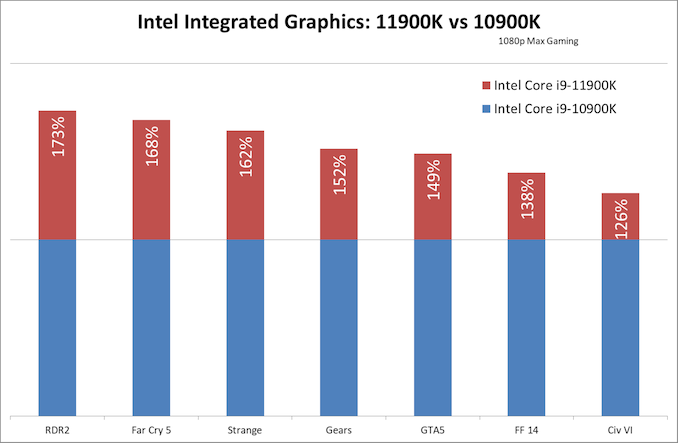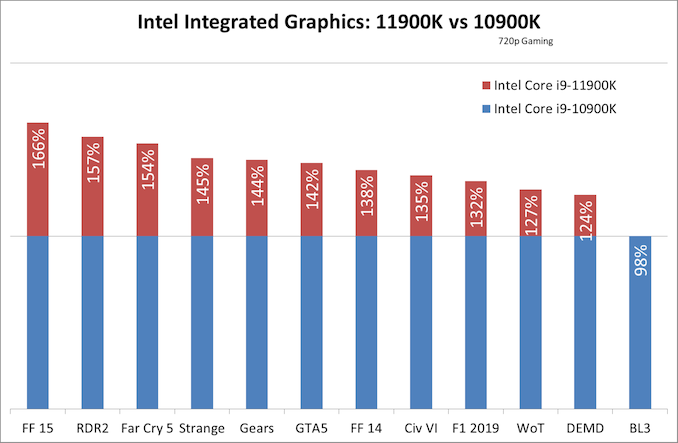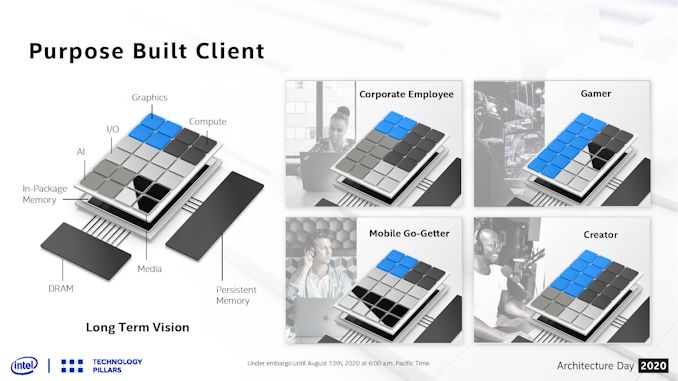Intel’s Integrated Graphics Mini-Review: Is Rocket Lake Core 11th Gen Competitive?
by Dr. Ian Cutress on May 7, 2021 10:20 AM ESTConclusions
No-one ever said that integrated graphics solutions had to be good. Nonetheless there is always the desire for something better, something higher performance, and something suitable for end-users. At the beginning of the era of integrated graphics, the focus was on simply providing something basic for 2D work - applications on an operating system and no real graphics rendering to mention. That solution is simple enough, however the demand on integrated graphics has grown over time, especially as the demands we put on our devices have also grown.
A modern system, especially a commercial system or one designed for work, has to do it all. Anyone not working in graphics might depend on a integrated solution to navigate complex arty web interfaces for the tool they use, or rely upon the acceleration features now baked into those platforms. Also perhaps, from time to time, some mild gaming use as well, if not outright using the compute features of the graphics for transcoding or AI. These demands are most heavily focused on mobile platforms, and as a result mobile platforms from Intel tend to get the best integrated graphics solutions, especially in thin-and-light designs where a discrete graphics solution is too power hungry. Intel's mobile Tiger Lake-U series offers a sizeable 96 execution units of the latest generation graphics architecture, compared to the desktop processors we are testing today, that only have 32.
So what use is a desktop processor with integrated graphics?
AMD and Intel both have product lines with integrated graphics. From Intel, its integrated graphics is in almost everything that Intel sells for consumers. AMD used to be that way in the mid-2010s, until it launched Ryzen, and now we have separate CPU-only and CPU+Graphics options. This is where the company philosophy differs.
AMD's desktop processors with integrated graphics are primarily intended to be a whole system replacement, with users relying on the integrated graphics for all their graphics needs. As a result AMD puts a lot more processing hardware into its integrated graphics solutions for the desktop, and it results in a good gaming experience for entry level gaming.
Intel's route on the otherhand is a bit more basic. The desktop integrated graphics here has two main directions: first, as the basic graphics needed for an office system, or second, more of a fall-back option for when the discrete card doesn't work or fails in more premium desktop systems. The power isn't there for hardcore grunt like gaming of any serious note, but it is certainly enough to cover the basics.
Despite this, with the new Xe-LP graphics solution, Intel has some aces up its sleeve. First is AV1 decoding, which allows users to watch AV1 content without putting stress on the CPU. Second is video encoding accelerationt through QuickSync, which has actually been a part of Intel's graphics for a number of years. Third is a relatively new feature: Intel's 'additional processor' mentality. Normally when a system has a discrete graphics card, the integrated graphics is disabled. But now, with its latest mobile devices for example, when Intel pairs its mobile processor with integrated graphics with a second graphics solution at about the same performance, with the right software Intel allows both graphics to work asynchrouusly on two different problems. The limit to this in the past has been dictating which graphics is the video out rather than simply a compute accelerator, but Intel believes it has worked it out. However, this is relatively little use for gaming, the topic of today.
Results Summary
In this review, we highlighted that Intel has now implemented its new Xe-LP graphics architecture onto its desktop processor line, and tested the new solutions against our traditional CPU gaming test suite. What we saw, in terms of a generational uplift from the i9-10900K to the i9-11900K, is actually quite impressive:
In our 720p testing, there's a clear generational gain across the board for Rocket Lake, and in most cases the games become a lot more playable. The average gain is 39%. If we flip to our gaming results at the higher resolution and settings:

Games with under 10 FPS across the board are left out
For these titles, the average gain is 153%, showing that Xe-LP is certainly a step up regardless of the workload.
The Future of Integrated Graphics
A key talking point about integrated graphics is whether a company should leverage a strong CPU product at the expense of graphics, or aim for something with strong integrated graphics as a more complete chip at the expense of the mid-range graphics market. The console market for example relies fully on integrated graphics designs, especially as it keeps the manufacturing simpler and number of chips lower. But on the desktop space, because discrete graphics are an option (well, when we're not in a mining craze or semiconductor shortage), there seems to be no impetus for companies to do a full fat integrated graphics solution that competes on the same stage as a mid-range graphics card. AMD could do it, but it might overlap with their console agreements, and Intel hasn't done anything serious since Broadwell.
To put a nod to Broadwell, Intel's 5th Gen processor. It was so powerful at integrated graphics at the time, we are still using it today as a comparison point when comparing against other Intel solutions. Broadwell had dedicated 48% of the die area of its top processor to graphics, and for that product it also added some really fast cache memory as well. Intel's focus on integrated graphics as a function of die size has decreased over time, now with Rocket Lake sits at around 20% of the silicon. It hasn't been this low since Intel first introduced its integrated graphics solutions. For that 20%, we get 32 execution units with eight processing cores. Tiger Lake has 96 EUs which total around 33% of overall die size, but has four cores. If Intel was focused on graphics performance in the same way as it was in Broadwell, we might be looking at a 256+ EU solution.
With Intel taking a renewed approach to graphics with its Xe portfolio, stemming from entry up to high performance compute, there is room here for Intel to develop integrated graphics focused solutions. Intel has detailed that it is moving to chiplets with its future mainstream processors under its 'Client 2.0' strategy, and part of that is allowing customers to select how many IP blocks they want of cores, IO, memory, security, and graphics. In the image above, the Gamer option has half of the die area for graphics. This could at the end of the day be a target that could see Intel making desktop integrated graphics a focus again.












165 Comments
View All Comments
GeoffreyA - Monday, May 10, 2021 - link
Yes, the notable thing about Sandy was the microarchitecture, which they reworked considerably, switching to physical register files, adding AVX in a way that was efficient, and the celebrated micro-op cache.Spunjji - Monday, May 10, 2021 - link
Yup, I think sometimes people forget that the architecture does have a lot to do with how high a processor can be clocked (alongside the manufacturing node of course).GeoffreyA - Monday, May 10, 2021 - link
A good example is how the Pentium 4 reached 3.8 GHz in 2004/5.Hifihedgehog - Friday, May 7, 2021 - link
Now just to buy a 5700G system and harvest one for the benchmarks, Ian!https://www.officedepot.com/a/products/5448005/HP-...
ozzuneoj86 - Friday, May 7, 2021 - link
Yes, this CPU looks like it could be the sleeper CPU of 2021. Early benchmarks are showing it beating almost every other 8-core (or less) chip, usually by a landslide, just like the 5800X... and yet you can buy a whole prebuilt system with one of these right now for $550. I have a 3600 right now and I can see buying one of these systems, finding a cheap APU and swapping them out and reselling the prebuilt so I can get a very cheap processor upgrade.Hifihedgehog - Friday, May 7, 2021 - link
The downside which is stated on the motherboard’s spec sheet, and I can confirm as one who has bought one, is HP locks their B550A motherboard’s firmware to just 5000G APUs. I tried a 4000 series APU—no dice. And another user on Reddit tried a 3200G—no joy.ozzuneoj86 - Friday, May 7, 2021 - link
Wow! Thank you for the information.What a joke! HP and Dell prebuilts these days are the worst in decades IMO. Towers these companies sold from the Athlon 64 through Haswell eras (10+ years) were mainly standard micro-ATX systems with very little proprietary stuff or artificial limitations (aside from chipset and microcode limitations brought on by Intel). I'm not familiar with all of the models made since then, but over the last 5 years I've seen so many desktops\towers with artificial limitations it is sickening.
I kind of doubt it will happen, but it'd be nice if someone figured out how to add other CPUs to the firmware. I wonder if they used an exceedingly small ROM so that it simply can't hold the microcode needed to recognize them (remember all the news about boards getting BIOS updates to add Zen 2 support but requiring that they drop several Zen 1 chips due to space limitations).
This is a very confusing time for PC enthusiasts. We have so many interesting things going on with affordable insanely powerful multi-core CPUs (and software that uses them!), the biggest generational leap in GPU performance in years (RTX 3000 series), hardware ray tracing, extremely fast SSDs (with DirectStorage coming soon!), Intel entering the GPU market, AMD making the best CPUs for the first time since 2005... and yet here we are with massively overpriced hardware that is hard to find, and OEMs like Dell and HP deliberately going out of their way to make their products undesirable to people who actually STILL LIKE DESKTOPS. You'd think all of these companies would be embracing all of the things that make computers (desktops in particular) useful when consoles and mobile devices are such a huge threat to their business.
Hifihedgehog - Friday, May 7, 2021 - link
> You'd think all of these companies would be embracing all of the things that make computers (desktops in particular) useful when consoles and mobile devices are such a huge threat to their business.Greed is a mighty powerful drug. Just look at the quad-core shovelware Intel kept giving us until AMD finally got their act together.
Gigaplex - Saturday, May 8, 2021 - link
The Dell tower I had at work was Haswell and had a ton of proprietary stuff. The PSU and motherboard were not compatible with the 24 pin ATX standard. The motherboard powered the SATA drives.AntonErtl - Saturday, May 8, 2021 - link
Likewise for HP boxes with Sandy Bridge. We inherited several of those. I think that in addition to the PSU-MB connector, the case is non-standard, so you cannot use it with a standard MB. If the PSU or the MB fails, you pretty much can only throw the whole thing away. CPU and RAM are still standard, but if your have to replace the rest, the remaining value of these parts is so small that you probably decide not to reuse them, and instead go for a completely new system.